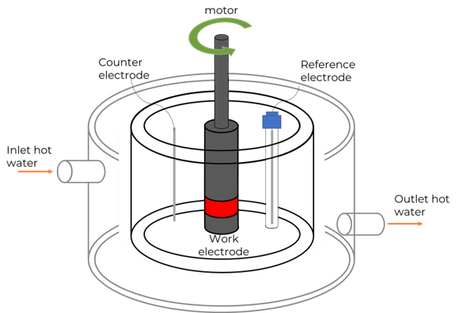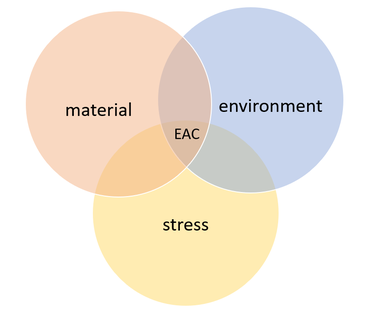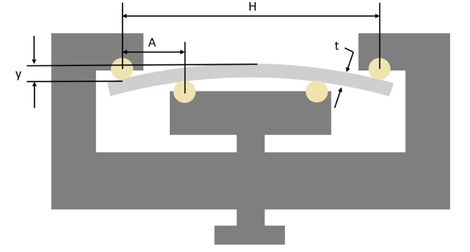Corrosion testing
-
Salt spray test
A salt spray test is a standardized accelerated corrosion test used to evaluate the corrosion resistance of materials and surface coatings. The method is primarily used for quality acceptance and comparison between materials and/or coatings. During the test, the material is placed in a closed temperature controlled chamber with a constant fog created from salty water. All tests are executed following the ASTM B117 standard.
-
Potentiodynamic scans (PDS)
This technique evaluates the corrosion behavior of a metal in a chosen environment. Specifcially, a potentiodynamic scan (PDS) provides an accurate measurement of the corrosion speed (current density), corrosion potential and some additional information on the corrosion kinetics of the system. Further variations in influential parameters like electrolyte composition, temperature etc. are possible and allow to better understand the behavior of a metal in its environment. Results of potentiodynamic scans are typically depicted by Tafel plots from which the corrosion current density and related corrosion rate are calculated.
-
Cyclic polarization (CP)
This technique is a cyclic variant on the potentiodynamic scan. On top of a basic metal-environment corrosion evaluation (information on speed and tendency), cyclic potentiodynamic polarization allows to investigate the susceptibility of a material to localized corrosion in chloride environments, mainly crevice and pitting corrosion. The test is frequently used for metals which have the ability to passivate and form protective oxide layers, such as stainless steels. When the passivation layer breaks down, the metal becomes sensitive to localized corrosion. The technique, as such, allows to study passive film formation and stability.
-
Electrochemical impedance spectroscopy (EIS)
Electrochemical impedance spectroscopy (EIS) is a test procedure that can measure the impedance of an electrochemical (metal-environment) system. This technique is an especially useful technique for the evaluation of longer-term performance of coated metals or testing of corrosion inhibitors that form coatings. In specific, this technique can relate the properties of the chosen (coated) metal-environment combination to an electrical circuit and provides information on resistance against corrosion and film properties.
-
Rotating cylinder electrode
This electrochemical cell is an expansion on electrochemical techniques like EIS,CP and PDS. By using a rotating working-electrode, this technique provides an extra, dynamic dimension to corrosion testing. Apart from variations in temperature, electrolyte composition, metal etc. , the relative flow speed can be varied separately to give more information on use cases that involve flow.

Rotating cylinder electrode set-up -
In-situ 4 point bending testing
Such tests allow to evaluate environmentally-assisted cracking (EAC), which is based on three pillars: material, environment and stress. Stress can be induced by mechanical testing in a corrosive environment.

Environmentally assisted cracking
To investigate the influence of a constant stress in an aqueous environment, four-point constant extension (4PCE) tests are often adopted. Four-point constant extension (4PCE) tests focus on a constant tensile stress with time. The sample is bent and the middle of the material is susceptible to a constant tensile stress at the top and a constant compression stress at the bottom. The constant tensile stress applied on the top of the metal beam can induce stress corrosion cracking in corrosive environments, such as seawater. Therefore, these tests give insight in the initiation and propagation of stress corrosion cracking in the material.

Set-up of a 4PCE test
By subsequent SEM analysis, the degradation depth of the corrosion processes at the tensile stressed surface can be evaluated. Hereby, the influence of the destructive synergism between stresses and environment on the material is determined.
-
SEM/EDX analysis of corroded surfaces
Corroded surfaces can be studied by a combination of SEM and EDX (more explanation can be found here) to characterize the damage induced by corrosion. SEM visualizes the corrosion products and damage at high magnifications, while EDX allows to determine the chemical composition of the surface layer and identify possible depositions. -
XRD for corrosion product characterization
XRD is a method used to define the crystallographic structure of a compound. Crystalline corrosion and scaling products have defined structures and can, therefore, be identified and quantified by XRD (more explanation on XRD can be found here) -
Inhibitor efficiency
The effectiveness of inhibitors for certain metal-environment systems can be evaluated by performing submerging corrosion tests. Weight loss measurements allow to determine the corrosion rate